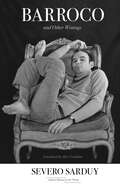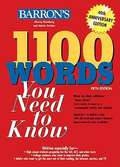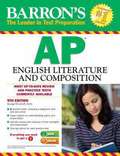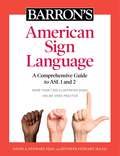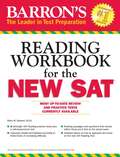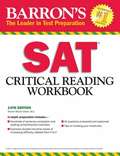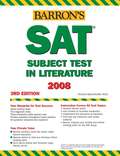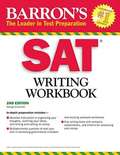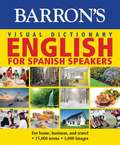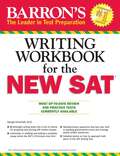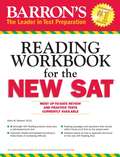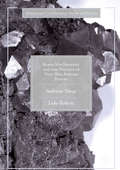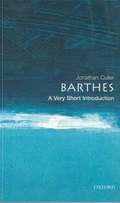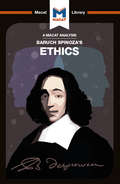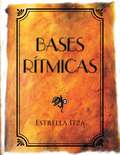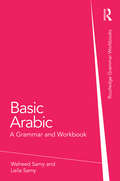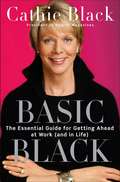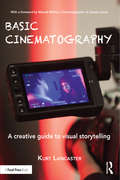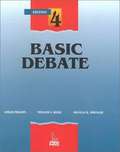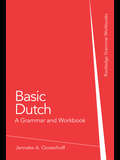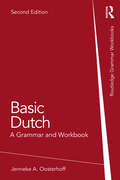- Table View
- List View
Barrio-Logos: Space and Place in Urban Chicano Literature and Culture
by Villa Raúl HomeroStruggles over space and resistance to geographic displacement gave birth to much of Chicano history and culture. In this pathfinding book, Raúl Villa explores how California Chicano/a activists, journalists, writers, artists, and musicians have used expressive culture to oppose the community-destroying forces of urban renewal programs and massive freeway development and to create and defend a sense of Chicano place-identity.
Barroco and Other Writings (Cultural Memory in the Present)
by Severo SarduySevero Sarduy was among the most important figures in twentieth-century Latin American fiction and a major representative of the literary tendency to which he gave the name Neobaroque. While most of Sarduy's literary work is available in English, his theoretical writings have largely remained untranslated. This volume—presenting Sarduy's central theoretical contribution, Barroco (1974), alongside other related works—remedies that oversight. Barroco marks a watershed in postwar thought on the Baroque, both in French post-structuralism and in the Latin American context. Sarduy traces a double history, reading events in the history of science alongside developments in the history of art, architecture, and literature. What emerges is a theory of the Baroque as decentering and displacement, as supplement and excess, a theory capacious enough to account for the old European Baroque as well as its queer, Latin American and global futures. In addition to Barroco, this volume includes texts spanning Sarduy's career, from 1960s essays published originally in Tel Quel to late works from the 1980s and '90s. It thus offers a complete picture of Sarduy's thinking on the Baroque.
Barron's 1100 Words You Need to Know (Fifth Edition)
by Murray Bromberg Melvin GordonUpdated to meet the needs of students preparing for the latest versions of the SAT and ACT college entrance tests, the new edition of this helpful, longtime best-selling book features word lists with definitions, analogy exercises, word games, and words-in-context exercises. A special feature is the authors’ Panorama of Words, in which each of the book’s 1110 words is presented in a sentence from a well-known novel, play, poem, or other literary source. A new “Bonus Materials” section commemorates this book’s 40th Anniversary as a leader in vocabulary building and test preparation.
Barron's AP English Literature and Composition (5th Edition)
by George Ehrenhaft Ed.D.In-depth preparation for the AP English Literature and Composition exam includes: Five full-length practice AP exams with all questions answered and explained Additional sample questions with answers covering poetry and prose fiction A review of test topics covering details test takers need to know about poetry, fiction, and drama Sample student essays with critiques of their strengths and weaknesses A detailed glossary defining 175 literary and rhetorical terms Updated guidelines for determining final AP exam score The manual can be purchased alone or with an optional CD-ROM that presents two additional full-length practice tests with automatic scoring and fully explained answers. BONUS! An exclusive online exam included with the purchase of the book or the book with CD-ROM!
Barron's American Sign Language: A Comprehensive Guide to ASL 1 and 2 with Online Video Practice
by David A. Stewart Jennifer StewartBarron&’s American Sign Language is a brand-new title on ASL that can be used in the classroom, as a supplemental text to high school and college courses, or for anyone who wants to learn proper ASL.The only book with comprehensive instruction and online graded video practice quizzes, plus a comprehensive final video exam.Content includes topics on the Deaf culture and community, ASL Grammar, fingerspelling, combining signs to construct detailed sentences, Everyday ASL, and much more.More than 1,000 illustrations of signs with instructions on movement--step-by-step with dialogue, tip boxes, and practice exercises and quizzes throughout to reinforce retention and to track your progress.
Barron's GRE 21st Edition
by Sharon Weiner Green Ira K. WolfThis newly revised and updated manual presents a test overview of the GRE, test-taking advice, and a timetable for a typical computer-based test. Added features include-- A diagnostic test with an answer key and answer explanations A verbal reasoning review with practice questions in sentence completion and reading comprehension An analytical writing review with scoring guidelines and practice exercises A quantitative reasoning review that includes general math strategies, discrete quantitative questions, quantitative comparison questions, and data interpretation questions Two full-length model GRE tests with answer keys and answer explanations.
Barron's Reading Workbook for the NEW SAT
by Brian Stewart M.Ed.This edition concentrates on the Reading Test with exercises reflecting all of the new SAT question types: reading comprehension; understanding words used in context; and graphical analysis. Exercises are divided according to three levels of increasing difficulty and labeled from A to C. The book features a helpful diagnostic test and 3 full-length Reading practice tests. All questions are answered and explained. Students who can answer all level C questions are ready to excel on the actual exam. The workbook also presents test-taking tips and vocabulary review.
Barron's SAT Critical Reading Workbook (14th Edition)
by Sharon Weiner Green Mitchel WeinerThis newly updated 14th edition concentrates on the SAT's Critical Reading section with exercises reflecting both SAT question types: sentence completion and reading comprehension.
Barron's SAT Subject Test in Literature 2007
by Christina Myers-ShafferComprehensive preparation for the test formerly called SAT II: Literature is presented here with seven practice tests, two diagnostic tests, and three interpretive skills practice sets. Students will also find reference material to help them develop critical reading skills, analyze literature, and write papers. A helpful chapter titled "Writing to Learn" teaches critical reading skills and the literary elements by showing students how to develop their own writing skills.
Barron's SAT Writing Workbook (2nd Edition)
by George EhrenhaftThe two-part Writing Test is an important component of the SAT, and this workbook offers college-bound students comprehensive preparation for both parts. Instruction in organizing one's thoughts, drafting, and editing an essay includes advice on completing the essay within the SAT's time limitation. This workbook also presents five writing tests with answers, explanations, and criteria for analyzing and assessing written essays.
Barron's Visual Dictionary:English for Spanish Speakers:For Home, For Business, and Travel (Barron's Visual Dictionaries)
by Pons Editorial TeamTravelers, students, and lovers of language will find this little visual dictionary to be indispensable. Small enough to slip into a purse or satchel, it includes thousands of common words identified by pictures and defined bilingually. Barron's Visual Dictionary: English for Spanish Speakers features approximately 15,000 words and concepts sorted into 13 clearly formatted and color-coded categories. Color-coded page headers make it quick and easy to find words in each category, from people, food, and communication, to education, leisure, and sports. This book also features:3,000 full-color pictures that provide helpful visualization for instant recognitionHelpful vocabulary boxes throughout to expand on abstract terms not covered by the picturesA bilingual index for quick and easy referenceIdeal for beginner and intermediate speakers, Barron’s Visual Dictionaries are also available in Spanish, French, and Italian.
Barron's Writing Workbook for the New SAT, 4th edition
by George Ehrenhaft Ed. D.This thoroughly revised edition of Barron’s Writing Workbook for the New SAT prepares students for the writing sections of the newly redesigned SAT: The SAT Writing and Language Test and The SAT Essay. It includes:
Barron's: Reading Workbook For The New SAT
by Sharon Weiner Green Brian W. StewartThis new edition concentrates on the new 2016 SAT's Reading Test with exercises reflecting all of the new SAT question types: reading comprehension, understanding words used in context, and graphical analysis. Exercises are divided according to three levels of increasing difficulty, labeled from A to C . Features a helpful diagnostic test and 3 full-length Reading practice tests. All questions are answered and explained. Students who can answer all level C questions are ready to excel on the actual exam The workbook also presents test-taking tips and vocabulary review.
Barry MacSweeney and the Politics of Post-War British Poetry: Seditious Things (Modern and Contemporary Poetry and Poetics)
by Luke RobertsThis book examines the literary impact of famed British poet, Barry MacSweeney, who worked at the forefront of poetic discovery in post-war Britain. Agitated equally by politics and the possibilities of artistic experimentation, Barry MacSweeney was ridiculed in the press, his literary reputation only recovering towards the end of his life which was cut short by alcoholism. With close readings of MacSweeney alongside his contemporaries, precursors, and influences, including J. H. Prynne, Shelley, Jack Spicer, and Sylvia Plath, Luke Roberts offers a fresh introduction to the field of modern poetry. Richly detailed with archival and bibliographic research, this book recovers the social and political context of MacSweeney's exciting, challenging, and controversial impact on modern and contemporary poetry.
Barthes: A Very Short Introduction
by Jonathan CullerRoland Barthes was the leading figure of French Structuralism, the theoretical movement of the 1960s which revolutionized the study of literature and culture, as well as history and psychoanalysis. But Barthes was a man who disliked orthodoxies. His shifting positions and theoretical interests make him hard to grasp and assess. This book surveys Barthes' work in clear, accessible prose, highlighting what is most interesting and important in his work today. In particular, the book describes the many projects, which Barthes explored and which helped to change the way we think about a range of cultural phenomena--from literature, fashion, wrestling, and advertising to notions of the self, of history, and of nature.
Baruch Spinoza's Ethics (The Macat Library)
by Andreas Vrahimis Gary SlaterBaruch Spinoza’s Ethics is a dense masterpiece of sustained argumentative reasoning. It earned its place as one of the most important and influential books in Western philosophy by virtue of its uncompromisingly direct arguments about the nature of God, the universe, free will, and human morals. <P><P>Though it remains one of the densest and most challenging texts in the entire canon of Western philosophy, Ethics is also famous for Spinoza’s unique approach to ordering and constructing its arguments. As its full title – Ethics, Demonstrated in Geometrical Order – suggests, Spinoza decided to use the rigorous format of mathematical-style propositions to lay out his arguments, just as the Ancient Greek mathematician Euclid had used geometrical propositions to lay out the basic rules of geometry. <P><P>In choosing such a systematic method, Spinoza’s masterwork shows the crucial aspects of good reasoning skills being employed at the highest level. The key use of reasoning is the production of an argument that is well-organised, supports its conclusions and proceeds logically towards its end. Just as a mathematician might demonstrate a geometrical proof, Spinoza sought to lay out a comprehensive philosophy for human existence – an attempt that has influenced generations of philosophers since.
Bases rítmicas
by Estrella ItzaBases rítmicas parece leve, pero no tardará en revelar su intensa carga. Su fuerza. Bases rítmicas es una creación de ayer, de hoy y de siempre. Siempre estará en la realidad que lleva consigo. A Estrella le gustaría, pues, que se deposite en la conciencia para meditar cada detalle. Abre el camino a varias reflexiones. Se recomienda con devoción que en esta enorme miniatura no se ande con prisa. Como ya se ha indicado, es una contraversión, sin igual, de la cigarra y la hormiga. Los ropajes que ha ido poniendo la autora a lo largo de la narración poemática son originales de principio al fin. La autora procede por insinuaciones. La idea no se manifiesta inicialmente, y casi no presenta a las protagonistas: la cigarra y la hormiga, junto con otros personajes fascinantes. La contraposición de las protagonistas así como el maravilloso lenguaje plástico, es rotundo y perfectamente delineado. ¿Es cuento lírico de sutilísimo desarrollo implícito? «Me limitaré a inquirir sobre las supuestas intenciones que han actuado en la conciencia y la mente de Estrella al configurar tan sugestiva y diáfana creación?» E. Alarcos LLorach de la R.A. de la Lengua 1922-1998
Basic Arabic: A Grammar and Workbook (Routledge Grammar Workbooks)
by Waheed Samy Leila SamyBasic Arabic: A Grammar and Workbook comprises an accessible reference grammar with related exercises in a single volume. This book presents 51 units, covering the key grammar points which students would expect to encounter in their first year of learning Arabic. Examples and exercises are provided throughout, allowing students to reinforce and consolidate their learning. Key features include: Clear, accessible format Many useful language examples Jargon-free explanations of grammar Abundant exercises with full answer key Subject index Clearly presented and user-friendly, Basic Arabic is an ideal grammar reference and practice resource for both beginners and students with some knowledge of the language. It is suitable for both class use and independent study.
Basic Arabic: A Grammar and Workbook (Routledge Grammar Workbooks)
by Waheed Samy Leila SamyBasic Arabic: A Grammar and Workbook comprises an accessible reference grammar with related exercises in a single volume.This book presents 51 units, covering the key grammar points which students would expect to encounter in their first year of learning Arabic. Examples and exercises are provided throughout, allowing students to reinforce and consolidate their learning.Key features include: Clear, accessible format Many useful language examples Jargon-free explanations of grammar Abundant exercises with full answer key Subject index Clearly presented and user-friendly, Basic Arabic is an ideal grammar reference and practice resource for both beginners and students with some knowledge of the language. It is suitable for both class use and independent study.
Basic Black: The Essential Guide for Getting Ahead at Work (and in Life)
by Cathie BlackCathie Black is the wise, funny mentor that every woman dreams of having. She was a pioneer in advertising sales at a time when women didn't sell; served as president and publisher of the fledgling "USA Today"; and, in her current position as the president of Hearst Magazines, persuaded Oprah to launch a magazine.<P> In 2006 she was named one of Fortune's "50 Most Powerful Women in American Business" for the seventh consecutive year. Now, in the exuberant, down-to-earth voice that is her trademark, Cathie explains how she achieved "the 360 degree life"--a blend of professional accomplishment and personal contentment--and how any woman can seize opportunity in the workplace.<P> No matter where you are in your career, "Basic Black" offers invaluable lessons that will help you land the job, promotion, or project you're vying for. At the core of the book are Cathie's candid, personal stories. She walks us through her decision to risk dropping a huge ad agency that handled the "USA Today" campaign in favor of a small boutique agency run by a wild man. (It was a smash.) She admits that her sometimes brusque style once led to a mutiny of staffers at Ms. (She learned to be more flexible in her managerial style.) She offers a clear-eyed look at what happened during the twenty-eight months between the launch and the close of the much-buzzed-about "Talk" magazine. And throughout, she offers fascinating glimpses of media and business personalities, such as Rupert Murdoch, Tina Brown, Frank Bennack, Vic Ganzi, former "CosmoGirl!" editor Atoosa Rubenstein, Bonnie Fuller, and the legendarily difficult Al Neuharth, founder of "USA Today".<P> Above all, "Basic Black" is motivating. It provides a close-up look at the keen judgment, perseverance, and optimism that have propelled Cathie Black to the top of her game, along with the kind of straight-up practical advice you get in a one-on-one session with a career coach. You'll find out how to handle job interviews, which rules to break, and why you should make your life a grudge-free zone. Equally important, you'll be inspired to pursue your passions and achieve your very best.
Basic Cinematography: A Creative Guide to Visual Storytelling
by Kurt LancasterThe cinematographer must translate the ideas and emotions contained in a script into something that can be physically seen and felt onscreen, helping the director to fulfil the vision of the film. The shots may look good, but they will not serve the story until the composition, lenses, and lighting express, enhance, and reveal the underlying emotions and subtext of the story. By making physical the ideas and emotions of the story, the cinematographer supports blocking as a visual form of the story through these tools. Rather than delve into technical training, Basic Cinematography helps to train the eye and heart of cinematographers as visual storytellers, providing them with a strong foundation for their work, so that they’re ready with creative ideas and choices on set in order to make compelling images that support the story. The book includes tools, tables, and worksheets on how to enhance students and experienced filmmakers with strong visual storytelling possibilities, including such features as: Dramatic script analysis that will help unlock blocking, composition, and lighting ideas that reveal the visual story Ten tools of composition Psychological impact of lenses, shot sizes, and camera movement Six elements of lighting for visual storytelling What to look for beneath the "hood" of cameras, including using camera log, RAW, and LUTs Dramatic analysis chart and scene composition chart to help plan your shoots Case studies from such visually cinematic shows and documentaries as Netflix’s Godless, Jessica Jones, The Crown, and Chef’s Table, as well as examples from classroom exercises Features insights from the DP of Jessica Jones, Manuel Billeter, and the DP of Chef’s Table, Adam Bricker.
Basic Composition: Student Workbook
by Center for Learning Network StaffThis workbook contains all the student handouts from the corresponding Teacher Guide (1-56077-664-1).
Basic Debate (4th edition)
by Leslie Phillips William S. Hicks Douglas R. SpringerBasic Debate is ideal for beginning debaters and has become a classic text that teaches the fundamentals - from the skills of analysis, research, logical reason, and argumentation to the techniques of cross-examination debate, Lincoln-Douglas debate, and student congress.
Basic Dutch: A Grammar and Workbook (Grammar Workbooks)
by Jenneke A. OosterhoffBasic Dutch: A Grammar and Workbook comprises an accessible reference grammar and related exercises in a single volume. This Workbook presents twenty-five individual grammar points in realistic contexts, providing a grammatical approach which will allow students not already familiar with these structures to become accustomed to their use. Grammar points are followed by examples and exercises allowing students to reinforce and consolidate their learning. Suitable for class use or self-study, Basic Dutch introduces Dutch culture and people through the medium of the language used today, providing students with the basic tools to express themselves in a wide variety of situations. Features include: useful exercises and a full answer key grammar tables for easy reference frequent comparative references to English grammar an appendix of irregular verbs an index of grammatical terms.
Basic Dutch: A Grammar and Workbook (Routledge Grammar Workbooks)
by Jenneke A. OosterhoffBasic Dutch: A Grammar and Workbook comprises an accessible reference grammar and related exercises in a single volume. This second edition contains new chapters on spelling, pronunciation, and indirect speech, as well as revised and additional exercises with lists of new vocabulary.This comprehensive book presents 31 individual grammar points in realistic contexts, taking a grammatical approach that allows students not already familiar with these structures to become accustomed to their use. Grammar points are followed by examples and exercises, allowing students to reinforce and consolidate their learning. Key features include: a full answer key grammar tables for easy reference frequent comparative references to English grammar appendices of pronunciation, pronouns, and strong verbs a list of new vocabulary at the end of each chapter Suitable for class use or self-study, Basic Dutch is the ideal companion for students in their first year of study, providing the basic tools needed to communicate in a variety of situations and an introduction to Dutch culture.

